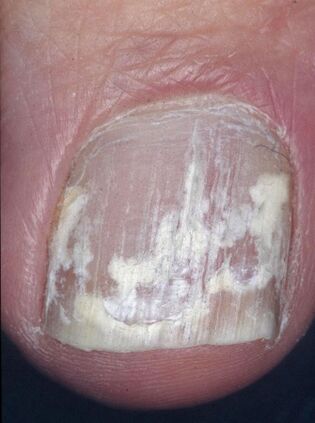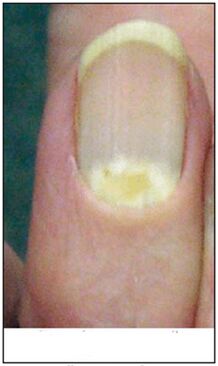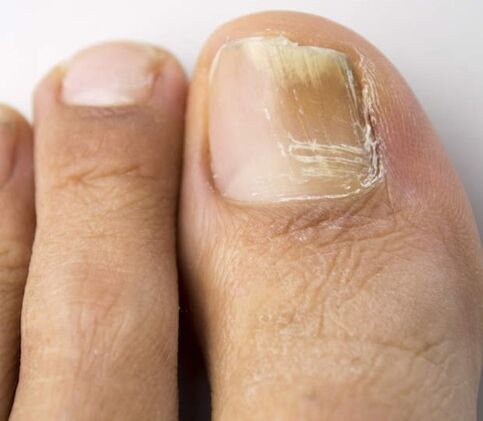To start treatment of onychomycosis in time, you should know what the fungus of the nails looks like.Mushrooms relating to the types of dermatophytes, candidates and yeast can cause the disease.The rapid and correct determination of the pathogen will allow you to quickly and effectively cure the fungus on the legs.
What is the nail fungus?
Fungal nail disease has a scientific name - an onychomycosis, which of ancient Greek means "chronic infection".This disease affects the nail plate in which power has been broken for any reason.Mushroom disputes spread quickly, they do not need special conditions for development.The disease itself does not occur due to the high survivability of fungi.
Causes of nail mushroom
Factors, as a result of which the fungus of the nails manifests:
- Wet and hot environment.After a long day spent in shoes, the legs sweat a lot.It is necessary to dry the shoes and completely abandon the synthetic socks.
- Age.The greatest number of cases of illness occurs at the age of 18 to 55.Basically, men suffer.If in young people, nail fungus occurs extremely rarely, then in elderly men, the percentage of incidence of at least 90%.This is mainly due to the decreasing growth of nail plates.
- Drugs.Taking medication, such as antibiotics and cytostatics, can cause disease.
- The immune system.Having passed unprotected legs on any dirty surface, you can easily infect yourself.A person with low immunity to do so is much easier.
- Occupation.The nail fungus can occur due to the high temperature in the work room, the joint or the ionizing radiation.Mine employees, medical establishments, baths and showers are most sensitive to the disease.
Three main paths have been identified through which the fungus is capable of falling under the nail plate of the leg:
- Through the nail roll.The nail roll is a fold of skin surrounding the nail plate on 3 sides.
- Through the edge of the nail.In this case, the fungus falls under the nail, not on it.In the future, this can be transformed into keratosis - a disease during which the nail begins to separate from the nail bed.
- Through the dorsal part of the nail.This part is the most durable, which is why, through it, the fungus penetrates much less often.
Types of nail mushrooms
What the fungus of the nails depends on the particular type of fungus caused the disease
Dermatophytes
This is the most common fungal disease type.The nail plate with dermatophyte is assigned in 90% of cases.
There are 3 varieties of this disease, each of them has a different territory of the lesion:
| Trichophyte | Affecting nails and feet |
| Epidermophyte | The fungus manifests itself on the 1st and 5th toes |
| Trichophyte | The fungus manifests itself on the 1st and 5th toes, can go to the interdictal folds |
Molds
This type of disease is extremely rare.When infected, the nail plate changes its color and becomes black, yellow, brown or blue.
Yeast mushrooms
These mushrooms are able to manifest not only on the nails, but are also the cause of the church in girls.The disease makes nails thinner.The nail plate acquires yellow.If the disease is ignored, it is possible to separate the nail from the box.
Steps of the disease

To which the fungus of the nails depends on the scene of the disease.
In medicine, it is usual to distinguish the 3 main steps from its development:
- At the first stage, it is quite difficult to identify the presence of the fungus.All because there are no visible signs.
- The second step.By moving towards the second step, the nails lose their chandelier, the color of the plate is gradually starting to change.The nail becomes more brittle on the edges.You can already see small stains or white grooves, which, over time, will increase in size.
- The third step is a form of neglected pathology, when a person has ignored the disease for a long time and has not treated it.Currently, there is a huge risk of losing the nail.It starts to largely and break more and more.
What the nail fungus looks like: symptoms and signs
The fungus has serious symptoms.At the start of the disease, the brilliant on the nail gradually disappears.The surface of the plate becomes small white wave -shaped spots.
Over time, the nail becomes brittle, scaly.Despite its fragility, the thickness of the nail can increase.Perhaps an unbearable feeling of itching between the fingers.Sleeping in the legs gradually increases.Probably the occurrence of horns and bubbles.
Another distinct sign of the disease is an unpleasant odor.This is due to the fact that the gap between the nail and the bed is clogged with dirt and mushroom products.
When the disease is highly launched, the patient can increase temperature and pain in the legs, which prevents him from moving normally.
Regional onychomycosis
Regional onychomycosis is the initial stage of the disease.It is quite difficult to determine the disease at this stage.
To which the fungus of the nails depends on the degree of development of pathology.Narrow gray lines appear gradually along the edges of the plate.The nail itself begins in Terne.In the center of the nail, small yellow spots occur.The plate does not change thickness, but it becomes fragile.
The nail is not completely affected.Only its individual sections suffer.Therefore, the surface of the affected nail is hidden.Under the nail, you can consider the gray matter, but the nail itself does not become thicker.
Normotorophic

Normotrophic onychomycosis occurs for the same reasons as the rest of the fungus.The microorganisms enter the skin, after which they penetrate its surface by small damage deeply in the nail plate.
With normotrophic onychomycosis in the first days of the disease, the color of the nail does not change completely, but only in the areas.On the sides and at the end, the nail becomes white, yellow or gray.The nail plate loses its brilliance and fades.Over time, the color of the nail changes completely, but its thickness does not decrease.
Hypertrophic
Hypertrophic onychomycosis is considered an advanced form of a normotrophic type of disease.The causes of its occurrence are not different from the causes of other types of nail mushrooms.
The occurrence of hypertrophic onychomycosis contributes to contact with infected people, wearing uncomfortable shoes or hygiene disturbance.The cause can also be diseases: HIV, hyperhidrosis and diabetes.
On the legs with hypertrophic onychomycosis, the thickness of the nail increases considerably.The thickening of the plate can cause a disease such as hyperkeratosis (with a disease, the skin under the nail becomes keratinized).
The color of the plate changes, because of which it looks yellow or gray.The nails become opaque, dull.The appearance of onichogrifosis is possible - a fungus in which the nail is distorted and takes the form of a bird label.
With hypertrophic onychomycosis, the side parts of the nail are most strongly suffered.As a result, intense pain in the fingers occurs, preventing a person from moving normally.
White superficial shape

The white surface shape of onychomycosis is the rarest type of disease.With him, the nail of the thumb and little finger is damaged.
With the disease, the nail leg and the matrix do not suffer.White spots appear gradually on the surface of the nail.Over time, their size and their area increase.The color of the spots goes from white to yellow.The nail begins to collapse.
If the disease is launched, inflammation of the skin around the nail is possible.With him, serious redness and itching appear.
The thickness of the plate does not change and its surface becomes rough.Often the nails break, shine.
People who visit most in danger of getting sick:
- Thermal baths;
- saunas;
- Public books.
The combination of high humidity and heat is an ideal environment for the rapid development of fungal disease.People who use common hygiene and shoes products are very at risk.
The white surface shape of onychomycosis is easy to confuse with such diseases:
- Seborrhea.
- The first step in eczema.
- Psoriasis.
Consequently, the dermatologist does not stop at a visual examination of the patient.Mandatory takes biological equipment and sends it to the laboratory to determine the type of pathogen.
Onycholithic
Onicholytic onychomycosis is characterized by the separation of the box nail plate.The nail loses its shine and becomes gray.In the damage area, there is a plot which is covered with hyperkeratosis (excessive thickening of the stratum layer of the epidermis, it can be 1 mm to several cm).
With a disease, thickening of the nail and slimming are possible.
Onychomycosis Candida
This type of disease occurs due to a decrease in protective properties of skin coating and low immunity.Candida mushrooms, which live in the intestines and urinary tracts, are starting to multiply quickly and to populate the nail plates.The disease is the most frequent in the female half of the population.Most often, people working with servers and dishwasher suffer.
At the start of the disease, the fungus affects the nail roll and the skin next to it.The skin rolls and begins to become inflamed.The roller swells, the skin on it disappears practically.If the disease is not treated, it can develop in chronic and take off from the skin in the nail and nail roller area will remain forever.
The refusal of the treatment can cause a deformation of the nail.It starts from the roll in the center of the nail.It becomes thinner and with slight pressure on the plate, pus is possible.In the plate itself, the white wave-shaped scratches are clearly visible.
There is a proximal candida onychomycosis.The difference is that the nail roll does not suffer.The determination of the disease is helped by white points of small sizes under the nail.
The third form of Candida onychomycosis is distal.The fungus affects the distant part of the nail and moves to its middle.The color of the plate changes and the nail becomes thicker.Hyperkeratosis occurs under the nail, as a result of which the nail increases.
Proximal deform

Proximal deforming onychomycosis begins to develop in the event of candida lesion of the nail plate.The main characteristic of the disease is the bed of the nail.With this form of the disease, it is distorted and becomes in the form of a wave.
Atrophic
Atrophic onychomycosis is characterized by a color change in the brownish gray nail plate.The nail is affected by the outer end and gradually moves to the skin roll.
There are also such signs:
- Loss of a natural nail shiny.
- The plate is atrophied.
- The nail bed is exposed.
- The nail is thinner and atrophy in the future.
- There is a superposition of skin ladders on the nail bed.
- The infection applies to neighboring fabrics.
With an atrophic onychomycosis, only the germ of the nail does not remain touched.
Treatment methods
Before starting the treatment of any form of onychomycosis, you must contact a dermatologist for the diagnosis.It is only after laboratory tests and determined the size of the affected areas, an additional patient treatment is prescribed.
As a rule, in the treatment of onychomycosis, local drugs and drugs are used to take orally.
For more effective treatment, in addition to taking medication, it is recommended to treat personal items and general items to exclude reinfection.
Maybe the treatment with the following ways:
- Physiotherapy.This procedure is prescribed to improve the blood circulation of members.Physiotherapy is used in combination with UHF and amplipuls-carlation on lombo-sacred and cervical departments.Laser therapy and diathermia are also used.
- In the case of neglected disease, when the nail is distorted and exfoliated, doctors decide to remove the nail plate.This will also prevent the propagation of the fungus and will give drugs more effectively to work on a healthy surface.
Pharmacies
The main methods of fighting fungal diseases include anticicotatics.They cause more harm in the fungus of the nails and therefore effectively treat affected areas.Antimicotics are suitable for the treatment of almost all types of diseases, with the exception of the candidate (the treatment here must be selected individually).
Dermatologists often prescribe the following anticicotics:
- Varnish that can protect the nail against the subsequent development of the disease.
- Solutions that destroy the fungus of nail rolls and the plate itself.
- ONGUENTS or GELS that relieve itching and inflammation.
When local treatment does not give the right effect to the maximum, preparations are prescribed to take inside.The main difficulty of dealing with such means lies in a large number of contraindications and precautions.The effect of drugs gradually increases.
Traditional medicine
In the treatment of fungal disease, popular medicine can be used, but only in conjunction with other drugs.
Tea mushroom

To use it, it is necessary to cook your cooked steamed legs.After that, a small piece of fungus is applied to the sick nail, folded with a bandage.The compress holds overnight and the morning is deleted.Deleted the dead areas should be removed, then treat the surface with any antiseptic.The course of treatment lasts several weeks.
Air
The decoction of Calamus is also able to become a assistant in the fight against the fungus of the nail.Take such a decoction 3 times a day.During reception, it is necessary to cut coarse skin and growth nails.
- To prepare the product, it is necessary by 2 tsp.Growing the rhizomes of the plant and pour boiling water (as a rule, 100 ml is enough).
- Then the rhizomes are boiled in the water for no more than 1 min.
- When the product has cooled, it is ready to use.
Due to the fact that the decoction has a bitter taste, it can be washed with water.
Acetic baths
Acetic baths only have a good effect at the initial stages of the disease.In the future, they are only used with the permission of the doctor and with other drugs.
Acetic baths soften the epidermis, improves blood circulation and also transforms the appearance of the feet.
Vinegar can be used in combination of the following components:
- Soda.He significantly softens the epidermis and improves the effect of the procedure as a whole.To prepare a solution to the procedure, it is necessary to stir 0.5 tablespoon on 3 liters of water.Vinegar with 2 tablespoons.L.soda.
- Essential oils.Such a component reduces the course of treatment several times.For a vinegar bath, 3 drops of oil are necessary.
- Glycerol.For 3 liters of water, 9 tablespoons.L.Vinegar and 3 tablespoons.L.glycerol.When preparing the solution, glycerin is added to water for better dilution.Glycerin in vinegar baths help hydrate the skin of the legs.
Baths can also be used as prevention.
There are a number of contraindications in which vinegar baths cannot be used:
- Oncology.
- Wounds, ulcers and stripes on the legs.
- Individual intolerance.
- Thrombophlebititis.
- Pregnancy.
- Cardiovascular system violations.
- Aging up to 10 years.
Before the procedure, you must perform 3 steps:
- Do a sensitivity test.A small area near the elbow is moistened with a prepared solution.After 15 minutes.There should not be any allergic reactions (itching, burns, redness).
- Before the procedure, the legs must be steamed and the affected tissues are deleted.
- After the procedure, you should rinse your feet and dry well.For 2 hours, you cannot load your legs.
- The duration of the procedure is 10 to 20 minutes.
In general, treatment with vinegar baths lasts 2 to 3 weeks.
Tea tree oil
The use of tea tree oil contributes to the effective recovery of the affected nail.During the procedure, the oil must be applied under the nail in the calculation of 1 drop per nail.The procedure is carried out 3 times a day.The nail treated areas should be glued with a patch, so the effect of treatment will be higher.
Iodine treatment

In the fight against nail fungi, iodine is widely used.It is best to use a 5% solution for the procedure.All that is necessary for treatment is to apply an iodine solution twice a day to the affected area of the nail.
When applying iodine, a feeling of burning is possible.If the burning sensation is low and does not cause discomfort - everything is fine.If the pain is severe, the treatment of iodine should be stopped immediately.The processing course with an iodine solution is 2 to 3 months.
The advanced stage of the disease can lead to more serious consequences.Whatever the fact of independent treatment that the patient does, at the first signs, it is necessary to consult a specialist.By the way, the fungus of the nails looks like, the doctor may prescribe a complete treatment.Onychomycosis on the legs is treated fairly quickly and effectively with the right approach.
















